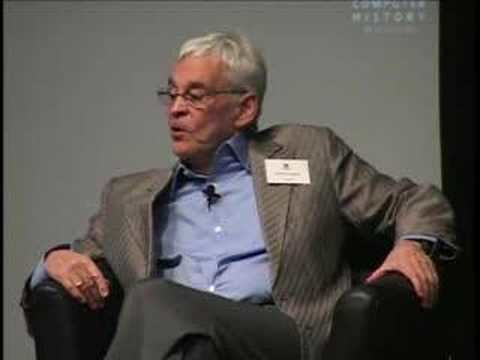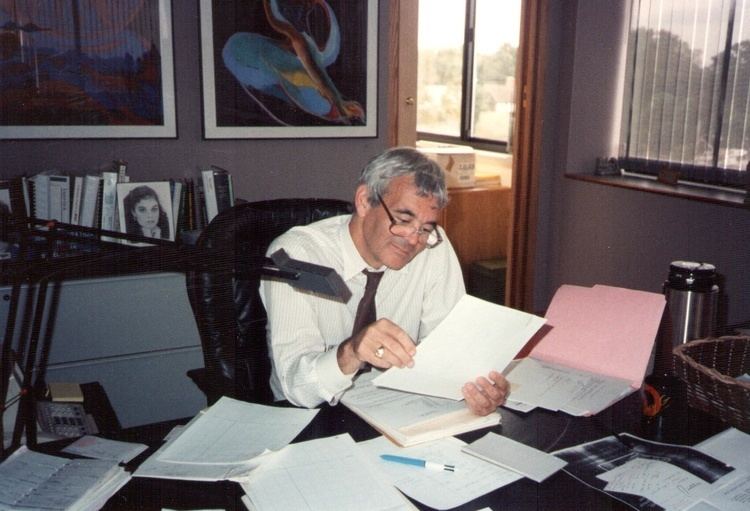Citizenship American | Name Gideon Gartner | |
 | ||
Organizations founded | ||
Gideon gartner on the magic quadrant
Gideon I. Gartner (born 1935) is the founder of Gartner, Inc. (formerly Gartner Group Inc. until 2001) a Stamford, Connecticut information technology (IT) research and advisory company.
Contents
- Gideon gartner on the magic quadrant
- Gideon gartner on the genesis of gartner group
- Early life and education
- Early career
- IT industry information businesses
- Gartner Group
- Selling to multiple constituencies
- Financing
- Nationwide sales organization
- Sales measurement and compensation model
- Peer level advisors
- Broad focus
- Research process and organizational culture
- Growth
- Soundview Technologies
- GiGa Information Group
- Personal life
- References

Gideon gartner on the genesis of gartner group
Early life and education

Gartner was born in Mandatory Palestine in 1935 and grew up in New York City. He graduated from the Massachusetts Institute of Technology in 1956 with a BSME. He graduated from the MIT Sloan School of Management in 1960 with a Master's degree.
Early career

Gartner began his career in the computer business. At IBM, he was Manager of Market Information in its Data Processing Division, and Systems Engineering Manager and Systems Engineer in IBM World Trade Corporation. He also worked for Philco Corporation in its Computer Division, and for System Development Corporation, working on two U.S. government large system contracts: SACCS (Strategic Air Command and Control System), and DCA (Defense Communication Agency Control System).
IT industry information businesses

In the years leading up to the formation of Gartner Group, Gartner was a partner at Oppenheimer & Co. He was voted the top individual technology analyst on Wall Street between the years 1972 and 1977 inclusive, in the annual poll of major banks, funds and other institutional investing firms, published by Institutional Investor Magazine.
Gartner Group

He founded Gartner Group (now called Gartner, Inc.) in 1979, and served as its CEO and Chairman through April 1991.
IT "advisory" firms are distinct from consultancies, in that they provide "continuous" advice to clients - defined in renewable (but open-ended) contracts which typically include a mix of "deliverables" including (but not limited to) content; client interaction with analysts and/or experts; and events. "Gartner Group became the preferred place a corporate client went when it had any question about the IT industry," noted one staffer.
In 1979, the primary "advisory" firms in Information Technology (IT) were IDC (International Data Corporation, part of IDG), Dataquest (now part of Gartner), and Yankee Group. Gartner's innovations, which were aimed at creating an advisory model which would address the evolving and complex needs of IT professionals and firms, included:
- Selling to multiple constituencies
- Financing
- Nationwide sales organization
- Sales measurement and compensation model
- Peer-level advisors
- Broad focus
- Research process and organizational culture
Selling to multiple constituencies
At the time, other advisory firms usually sold to only computer hardware, software and services vendors. Exceptions at that time included Dataquest (selling a service for investors), and Input Corp. (selling a service for users). Gartner sold to vendors, plus users (generally large enterprises and other organizations, such as government agencies), plus investors and consulting firms.
Investors were among the first targets, as Gartner had just resigned as partner of Oppenheimer & Co., but at Oppenheimer he had also begun servicing a group of Chief Information Officers (CIOs) of large corporations, which became the base for Gartner's enterprise activities. As Gartner Group's coverage of IBM was deep (IBM was the primary industry vendor at the time), other vendors desired to be tied into Gartner’s research network. Thus, the market Gartner addressed was unusually broad, and each constituency provided insights and information which benefitted others, arguably creating market advantage.
Financing
Gartner's venture capital financing was unique among advisory firms at the time. Gartner Group was initially financed by Bessemer Venture Partners and E.M. Warburg Pincus, with Bank Paribas joining a year later. This led to the firm being the first in its field to raise public capital in a 1986 offering, supporting its growth.
Nationwide sales organization
Raising capital from venture firms allowed Gartner to build a nationwide sales organization, the first of its kind in the industry.
Sales measurement and compensation model
Gartner instituted a sales measurement and compensation scheme, based upon how IBM had measured its rental sales, but novel when applied to consulting/advisory firms: since Gartner Group sold annual renewable contracts and recorded "Contract Value", it based progress reporting and compensation (commission for sales personnel and bonus for analysts and managers), on the growth of appropriate Contract Value (CV) during a period of time; this was called Net Contract Value Increase (NCVI). Uniquely, compared with all prior consulting and advisory models, all variable compensation was based upon growth and not on revenue from renewals, an important factor in developing a strong growth culture.
Peer-level advisors
Having come from Wall Street, Gartner adopted the idea of employing senior industry people, who were in fact "peers" of their prospective clients. This was a departure from the current industry practice at the time, where analysts were relatively young and relatively inexperienced albeit bright.
Broad focus
Instead of focusing primarily on market research, Gartner emphasized a basket of "values" including : G2 (competitive intelligence and analysis), quantitative methods for clients to analyze residual values and obsolescence metrics of IT hardware, saving money within the IT organization, and IT education within clients’ staffs.
Research process and organizational culture
Gartner developed a disciplined "research process", which was documented in a Research Notebook, used in regular training programs at the firm. Process highlights called for analysts to "scan" all sources of input, be trained in recognizing "patterns", develop "new ideas" from these patterns, and "document" the results in brief one-page "research notes". General industry practice at the time was to publish relatively long reports. Gartner research "gimmicks" were introduced, such as the "stalking horse", a research collaborative tool whereby analysts were compelled to graphically present and defend their logic at research meetings. Thus, the "horse" became the company mascot. Intensive research meetings for all researchers were conducted at least weekly, and provided additional training and other benefits. Other innovations were introduced, in areas such as research-hiring interview methods, conferences including the breakthrough Symposium, inquiry systems to connect clients with internal analysts. All the above contributed to an unusually strong and acknowledged organizational culture.
Growth
Gartner Group was ranked among the fastest growing private firms in the U.S. (by Inc. Magazine) until it went public in 1986, whereupon it was listed for several years among the best small companies in America (by Business Week, e.g. #9 overall, and #1 in profitability, in 1987). Gartner was sold to Saatchi & Saatchi in 1988, and Gartner signed a contract to remain as CEO until April 1991. In 1990, Gartner led a successful leveraged buyout of the firm financed by Information Partners, a private equity fund owned by Bain Capital and Dun & Bradstreet.
Gartner Group is generally recognized as the world's leading "advisory consulting" firm in the IT industries, based on annual revenues and market share.
Soundview Technologies
Gartner, who had retained contact with his Wall Street clients, initiated a new financial service for Gartner Group via a new partnership with Dillon, Read & Co., which distributed its reports and personal services to Dillon, Read & Co. investment client organizations. Gartner Group severed the Dillon Read relationship and became an independent broker-dealer in 1984, named Gartner Securities Corp., and spun this business out to its shareholders just before its first public offering in 1986, providing its analysis, investment advice and banking services, to all institutional investors. Its name was changed in 1988 to SoundView Technology Group, when Gartner was acquired by Saatchi & Saatchi. Soundview was unique in that it combined accepted Wall Street research and distribution methods, with the intimate (albeit "arms length") relationship with Gartner analysts, and arguably became the leading technology research boutique on Wall Street. But it merged in 2000 with Wit Capital, and was eventually sold (early 2004) to Charles Schwab Company, and thereafter completely absorbed into Schwab and UBS.
GiGa Information Group
Giga Information Group was founded by Gartner in 1995. He raised more than $15 million in several tranches to develop the company; he was Chairman and CEO until late 1999. In less than four years from first shipment (April 1, 1996 to December 1999), this innovative firm became the fastest growing technology advisory consulting company in history, generating a run rate from zero to over $65 million, with more than 1,200 enterprise clients.
Three primary innovations were introduced to the advisory business through Giga: its offering of a single comprehensive IT Advisory service (compared with the typical multiple services of other advisory firms), an external cadre of experts to supplement the strategic nature of analysts on staff, and a set of web functions which stressed objectivity of analysis, and allowed on-line research by clients (called “The Knowledge Salon”).
Giga went public in 1998, but its stock languished during and after the technology stock market meltdown of 2000. In February 2003 the company was sold to Forrester Research.
Personal life
Gartner lives in Aspen, Colorado and Stamford, Connecticut, and is involved in business ventures, athletics and classical music. His music background includes a lifetime of piano practice, as well as performing on the French Horn, having been a member of the London School Symphony Orchestra, and the Brooklyn Philharmonic (then called the Brooklyn Philharmonia). He is on the board of the Opera Orchestra of N.Y, is a trustee of the Music Associates of Aspen (the Aspen Music Festival and School), is a fellow of the Aspen Institute, and is on the National Councils or equivalent, of the Aspen Art Museum, and the Anderson Ranch.
He has served on the Library Committee of the M.I.T. Corporation and is a Sustaining Fellow Life Member of M.I.T. He is a past member of the board of the Society for Information Management where he was Special Appointee to the President. He is a Director's Circle member of the Charles Babbage Institute and a member of the Board of Directors of the IT History Society. In the 1977 joint exhibit sponsored by the ACM and Goldman Sachs in Washington D.C. and the Boston Computer Museum, documented in the book “Wizards and Their Wonders: Portraits in Computing”, Gartner was honored as one of the 19 “Communicator” stars in the IT industry.
Gartner's professional activities have included speaking before major organizations worldwide. He has addressed graduate student groups at Harvard Business School, M.I.T., Yale, University of Georgia, and Arizona State, among others. In 1985, Gartner taught a course at UCLA’s Graduate School of Management (GSM), which was formally rated by his students as their best course taken throughout GSM. Gartner has also written extensively, for example, the AMA journal, series of articles for Computer Decisions and Information Week magazines, and the forward and much of Chapter 7, in “The E-Marketplace…Strategies for success in B2B eCommerce”, by Warren Raisch (McGraw Hill, 2001).
He is an active angel investor in early-stage companies, and is a member of New York Angels.
